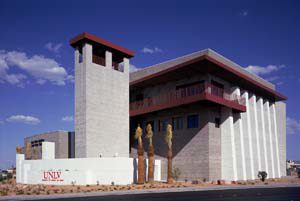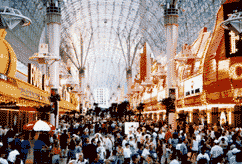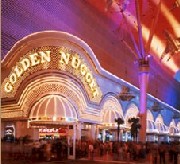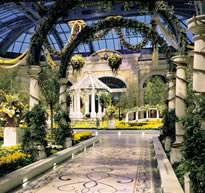|
|
|
ABLE 2003 Registration Form [no longer available]
|
|
Workshop Registration Form [no longer available]
|
Dorm Housing Form [no longer available]
|
|
|
|
|
Schedule of Mini Workshops [no longer available]
|
|
|
|
|
|
|
|
|
|
|
Connie Herr and Roberta Williams will host the 25th annual ABLE conference June 3-7, 2003 at the University
of Nevada, Las Vegas. This is the third time, in the history of ABLE, that the conference will be at UNLV. Many changes have occurred on campus since the last conference held here. Las Vegas is the fastest growing city in the USA and the campus has responded to this rapid growth. Our new state-of-the-art library is the largest state building in Nevada. UNLV is a fairly young (less than 50 years old) university and has many modern facilities.
Location: The conference will take place on the campus
of the University of Nevada, Las Vegas. The campus is located
approximately two miles from McCarran International Airport,
and within a couple of miles of the “Strip” hotels, casinos
and restaurants.
UNLV Accommodations: Rooms in the William S. Boyd Residence Hall
will cost $25 for shared space and $37.50 for
a single. Two rooms share a bathroom. Afternoon temperatures
at that time of the year may reach 100 F (but it is a dry
heat). Diurnal temperatures in the Mojave desert fluctuate
30 F. Go to: UNLV Campus Map
Conference registration will take place at the Boyd
Residence Hall Tuesday, June 3rd, from 10:00 AM to 1:00 PM
and from 3:30 PM to 6:00 PM and Wednesday, June 4th, from
7:30 AM to 8:30 AM. Most of the workshops will be in Juanita
Greer White Life Science building. A shuttle will be available
between the dorms and the life science building.
Major Workshops
WEDNESDAY, June 4, 2003
Major workshops 8:30 AM and repeated at 2:00 PM
[Go to Abstracts of Major Workshops] |
1 – Scientific Inquiry*, George Boone, Susquehanna
University |
2 – Bacterial Gene Transfer*, John Mordacq and
Roberta Ellington, Northwestern University |
3 – Using Ant and Butterfly Pollination to Involve
Students in Scientific Exploration*, Mary Blain Prince
and Mary N. Puterbaugh Mulcahy, University of Pittsburgh |
4 – Using Dermatoglypics from Downs Syndrome and
Class Populations to Study the Genetics of a Complex Trait*,
Thomas Fogle, Saint Mary’s College |
5 – DNA Microarray Data Analysis, Malcolm Campbell,
Davidson College |
6 – Invertebrate Locolympic, Charlie Drewers,
Iowa Sate University |
7 – All the “Plants” That Aren’t Plants, Clayton
Newberry, UNLV |
* Replay workshop (with updates) from last 10 years
of ABLE
(12:30, Invited Speaker, Stan Smith) |
|
|
8 – The Scientific Method: An Introduction Using
Reaction Time*, Robert Kosinski and John Cummings,
Clemson University |
9 – Introducing Students to Conservation
Genetics Using Sturgeon Caviar and Other Fish Egg Samples*
(1999), Kathleen A. Nolan, Saint Francis College |
10 – Investigating Polyploidy in Marigolds Using
Fingernail Polish, Kimberly Hunter, Salisbury University |
11 – Analysis of Cytogenetic Events Using Sordaria
fimicola, Steve deBelle, UNLV |
12 – Using Problem-Based Learning to Connect Concepts
with Laboratory Applications, Deborah Allen and Robert
Hodson, University of Delaware |
13 – Expanding the Nature of Science in Teaching
Laboratories: From Descriptions of Behaviour to Hypothesis
Formation and Evaluation, Ralph Prezler, New Mexico
State University |
14 – Discover the Mojave Desert’s
Secret Wetlands – A Unique and Useful Habitat, John
Bare, UNLV (FIELD TRIP 7:30 AM – 10:00 AM) |
* Replay workshop (with updates) from last 10 years
of ABLE
(12:30 PM, Invited speaker, James Deacon, Desert Fish)(5:00 PM, ABLE Business Meeting ) |
FRIDAY, June 6, 2003
Major workshops, 8:30 AM
[Go to Abstracts of Major Workshops] |
15 – Diversity of Photosynthetic Pigments*, Alex
Motten, Duke University |
16 – Practical Guide to the Use of Cellular Slime
Molds for Laboratory Exercises*, Donna Bozzone, St.
Michael’s College |
17 – Expression Vectors Used in Project-Oriented
Teaching Laboratories*, Susan Karcher, Purdue University |
18 – Discover the Mohave Desert’s Secret Wetlands
– A Unique and Useful Habitat, John Bare, UNLV (FIELD
TRIP 7:30 AM – 10:00 AM) |
* Replay workshop (with updates) from last
10 years of ABLE
12:30 PM, Carol Budd, incoming president of ABLE, will
speak about the Bioscience Education Network (BEN) Portal:
ABLE’s new partner |
FRIDAY, June 6, 2003
Mini workshops and poster session, 1:30-4:30 PM |
Tuesday Field Trips
(pick up for all field trips will be outside the residence hall)
Hotel Biology at the Mirage: The
Mirage Hotel has $50 million worth of non-native palm trees
around it’s exterior. Participants in this field trip will
meet with the horticultural staff and learn about the upkeep
of these magnificent trees. After touring the grounds, participants
will go into the hotel to view the atrium with a 100-foot-tall
glass dome that shelters a living rain forest of palms, banana
plants, orchids, bromeliads, and other vegetation. Behind
the registration desk is a 20,000 gallon aquarium built into
the wall. Siegfried and Roy’s white tigers are on display
in a glass enclosure just off the casino. For an additional
fee, participants may see the dolphin exhibit and the Secret
Garden that houses white lions. 1:00 – 4:00 PM. $15 per person
Hotel Biology at Mandalay Bay and
the Bellagio: Mandalay Bay Hotel is home to Shark
Reef, a 22 foot-deep, 1.6 million gallon aquarium that houses
more than 100 different marine species and features sharks
and rays from around the world. The self-guided tour starts
with marine wildlife, living displays of Asian reptiles, and
then leads to a well designed, conservation-minded array of
aquarium displays. The tour lasts about two hours. After the
tour, participants can take the monorail to neighboring Bellagio
Hotel and view the botanical conservatory. The display is
changed each season and the hotel has a staff of 115 to maintain
and care for the plants. The Bellagio also features a glass
sculptured ceiling made by the artist, Dale Chihuly. Two thousand
blown glass pieces make up the artwork “Fiori de Como”. 1:00
– 4:00 PM, $18 per person.
Hoover Dam and Ethel M’s Cactus
Garden: Hoover Dam is approximately 25 miles from
UNLV. The 726-foot dam constructed in 1936 forms Lake Mead,
the largest man-made lake (by water volume) in the USA. Participants
will visit the newly constructed visitors center where they
will watch a film about the construction of the dam. Then
they will have a guided tour of the dam and power plant. A
small portion of the water in Lake Mead is used by Clark County
residents and tourists. The majority of the water is piped
to Southern California where it is used for agriculture. Clark
County gets a small amount of its electricity (7%) from the
generators. Most of the electricity is also used by Southern
California. On the way back from the dam, we will stop at
Ethel M’s chocolate factory and cactus gardens. The Mars chocolate
company opened a small factory on the outskirts of Las Vegas
(in the 1970s, it is no longer the outskirts). The factory
makes gourmet chocolates. On the side of the factory, there
is a 2.5 acre collection of 350 species of desert plants and
cactus that is well worth strolling through. It is shady.
12:30 – 5:00 PM. $30 per person
Tuesday Reception
 ABLE conference participants are invited to a Welcoming Reception hosted by the College of Sciences. The reception will be held in the Stan Fulton International Gaming Institute, a new building devoted to education and research in the gaming industry. Only in Las Vegas would you have a reception in a building like this! ABLE conference participants are invited to a Welcoming Reception hosted by the College of Sciences. The reception will be held in the Stan Fulton International Gaming Institute, a new building devoted to education and research in the gaming industry. Only in Las Vegas would you have a reception in a building like this! |
|
Saturday Field Trips
Ash Meadows National Wildlife Refuge
(all day trip)
Ash Meadows National Wildlife Refuge is located approximately
90 miles northwest of Las Vegas in the Armagosa Valley. The
refuge covers 22,000 acres of spring-fed wetlands and alkaline
desert uplands and provides habitat for at least 24 plants
and animals found nowhere else in the world. This concentration
of indigenous life distinguishes Ash Meadows as having a greater
concentration of endemic life than any other local area in
the United States and the second greatest in all of North
America. Ash Meadows provides a valuable and unprecedented
example of desert oases that are now extremely uncommon in
the southwestern United States. The many ponds are home to
the desert pupfish and other native fish. The outstanding
clarity of the water makes viewing the fish easy. Dr. James
Deacon, the Thursday lunchtime speaker, will tell you about
his lifetime work in this area.
The drive to Armagosa Valley will pass by the US Air Force
bombing range, the Nevada Test Site and Yucca Mountain, the
proposed nuclear repository. Easterners will see why the US
government thinks that “Nevada was built for wastes”. All
participants will get a good view of the Mohave Desert geology
and flora. The drive back to Las Vegas will go through “brothel
city”. Prostitution, while illegal in Las Vegas (Clark County),
is legal in neighboring counties. Travel will be in air-conditioned
vehicles, but there is little shade at the refuge, so bring
hats, sunscreen and water. Departs from the residence hall
at 8:00 AM. Return will be early evening. $39 per person includes
lunch.
Valley of Fire and Lost City Museum
(all day trip)
Valley of Fire is a vivid land of bold cliffs of red and white
sandstone set in the midst of the grandeur that is the Mohave
Desert. The stories of powerful earth forces, adapting life
forms, and early man are all revealed in this unique parkland.
Deposition of limestones, shales and sandstones created the
many diverse materials subsequently eroded into dramatic forms.
Both wind erosion and chemical erosion have contributed to
the interesting and colorful collection of geological forms
that look like they are on fire when the sun reflects at certain
angles.
Native Americans occupied this area as far back as 4,000
years ago. Visitors will see many petroglyphs carved into
desert-varnished rock faces in Valley of Fire. A visit to
the Lost City Museum interprets the prehistory of the area focusing
on the Anasazi Indians.
The drive back to Las Vegas will allow participants to see
portions of the northwest side of Lake Mead.
Valley of Fire is approximately 60 miles from Las Vegas.
This trip will be in air- conditioned vehicles. The visitors
center and museum are air-conditioned. A short hike to Mouse
Tank is planned along a trail that has many petroglyphs. Hats
and sunscreen are recommended. Leaves from the residence hall
at 8:30 and returns around 5:00 PM. $40 per person includes
museum admission and lunch.
Red Rock Canyon Hike
(half day trip)
Escape the heat and see the beauty of the Mohave Desert
at Red Rock Canyon National Conservation Area. Located 20 miles
from the Las Vegas Strip, the gray limestone and red sandstone
canyon is at an elevation of 4000-6000 feet. The area contains
many hiking trails that give the hiker a chance to see nature’s
artistry close-up. The elevation of this area supports the
Joshua tree, Mohave Desert indicator plant. These cactus-like
trees look as if they are raising their arms in reverence
to a higher being, thus their name.
This trip will depart at 7:30 AM participants will do a
moderate hike. Hats, sun screen and sturdy shoes recommended.
Vehicles will return to UNLV around noon. $19 per person.
Arrow Canyon (three-quarter
day trip) Arrow Canyon is about 60 miles from Las Vegas. For eon’s
of time the winds and rains have eroded the rocks to make
a miniature Grand Canyon that has become a geologists
delight. The 60 foot limestone canyon walls contain a
variety of marine fossils. The rock strata were deposited
280-340 million years ago. At that time, a shallow sea
extended from Southern California to Canada. |
It is shady and cooler in the canyon and we will explore
it in four-wheel drive vehicles. The suburbans will
be at the residence hall at 8:00 AM and return around
3:00 PM. $60 per person, includes lunch. |
|






 ABLE conference participants are invited to a Welcoming Reception hosted by the College of Sciences. The reception will be held in the Stan Fulton International Gaming Institute, a new building devoted to education and research in the gaming industry. Only in Las Vegas would you have a reception in a building like this!
ABLE conference participants are invited to a Welcoming Reception hosted by the College of Sciences. The reception will be held in the Stan Fulton International Gaming Institute, a new building devoted to education and research in the gaming industry. Only in Las Vegas would you have a reception in a building like this!